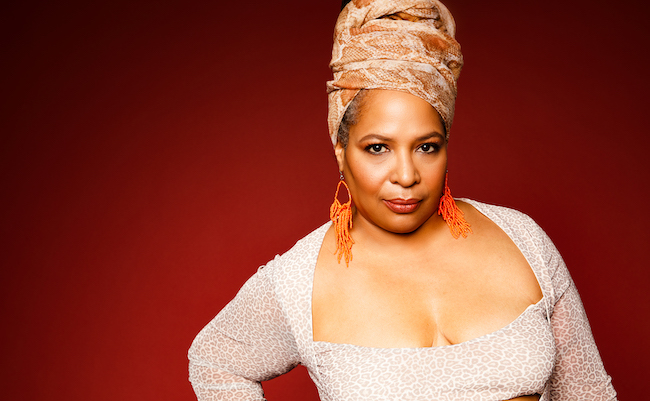Oct 28, 2025 10:47 AM
In Memoriam: Jack DeJohnette, 1942–2025
Jack DeJohnette, a bold and resourceful drummer and NEA Jazz Master who forged a unique vocabulary on the kit over his…

“I think his music is amazing, but I want other people to be engaged with his music as well,” said vocalist Fay Victor about composer Herbie Nichols.
(Photo: Deneka Peniston)Herbie Nichols is one of the great should-have-been stories in jazz. Born in New York in 1919 to parents from Trinidad and St. Kitts, he died of leukemia in 1963 having recorded only two albums and two 10-inch EPs. When he gigged, it was mostly as a sideman, and often in Dixieland or other artistically conservative contexts; he rarely got to perform his own music. In his book Four Lives In The Bebop Business, A.B. Spellman wrote, “If the products of an artist’s life work are to be the sum of his life, then Herbie Nichols … may be said not to have lived at all.”
It’s a shame Nichols was so unappreciated in his lifetime, because both his compositions and his performances of them mark him as a striking figure even at a time — the mid-1950s — when jazz was at a creative peak. Spellman described his style as falling “in a musicological sense, between … Teddy Wilson and Thelonious Monk,” and that’s both vivid and accurate. His melodies have the romanticism of Wilson, but the rhythmic drive and island feel of Monk.
In some ways Nichols might have been even “weirder” than Monk, as his compositions bore titles like “Argumentative,” “Cro-Magnon Nights,” “Amoeba’s Dance” and “It Didn’t Happen.” But he was also deeply drawn to songcraft; in an autobiographical essay quoted by Spellman, he wrote, “The voice is the most beautiful instrument of all; that’s why I’ll always write songs.” His most famous piece is “Lady Sings The Blues,” co-written with Billie Holiday; Mary Lou Williams also recorded several of his compositions in the early 1950s, giving them new titles.
Fay Victor was born in New York two years after Nichols’ death. They come from similar backgrounds: Her mother was from Trinidad, her father from Grenada. She began singing jazz in her 20s, but after a few years of struggle on the New York scene, she moved to Amsterdam, which sparked a personal and creative rebirth. She discovered the avant-garde jazz of ’60s heroes. “One of my biggest influences in terms of phraseology is Eric Dolphy,” she says. “I fell in love with Eric Dolphy the first time I heard The Blues And The Abstract Truth, from Oliver Nelson. So I just listened to follow what he did. And then by the time I got to Out To Lunch, I was just blown away.”
Victor connected with key Dutch jazz figures, including pianist Misha Mengelberg, who she says “saw in me what I didn’t even see yet, that I just had to go my own way, and he in his way [couldn’t] help but encourage that.” She also met bassist Jochem van Dijk, who became her boyfriend and eventually her husband; it was through him that she first heard Nichols’ music.
“I was rifling through his music collection and discovered a CD of Herbie Nichols,” she recalls. “I didn’t know — I’d never heard the name, didn’t know anything about this person. But … I took it out and I put on the record, and a lot of it was just way above my head. But the song that connected immediately was ‘House Party Starting.’ And I loved it. I fell in love with it so much that I decided, ‘I’m going to learn. I want to figure out how to sing this song today.’ And honestly, at that moment, I was not technically ready to sing such a song, but it was a good challenge to get ready.”
She included a version of “House Party Starting,” with her own lyrics, on her 2001 album Darker Than Blue (Timeless) and continued to explore Nichols’ catalog, performing his tunes alongside works by Monk and Ellington with Mengelberg and the Instant Composers Pool (ICP). When she returned to New York with van Dijk, she connected with trombonist Roswell Rudd, who had worked with the pianist at the end of his life. “I could ask Roswell questions because Roswell knew Herbie Nichols personally. For example, I got to know that the reason ‘House Party Starting’ is so dark is because Herbie Nichols was very, very shy, and … I remember thinking about [how] that must be like torture, to be an excruciatingly shy person and have to perform for a house party.”
Victor’s project Herbie Nichols SUNG has existed for more than a decade at this point, and she’s finally documented it on record. Life Is Funny That Way (Tao Forms) features her lyrics and arrangements, performed by alto and baritone saxophonist Michaël Attias, pianist Anthony Coleman, bassist Ratzo Harris and drummer Tom Rainey. Most tracks have new titles; the exceptions are “Shuffle Montgomery,” “Twelve Bars” and “Lady Sings The Blues.”
A lot of the arrangements started for piano, saxophone and vocals, put together in collaboration with pianist Achim Kaufman. “Achim and I got together over a period of years to figure out how to really break open Nichols’ music … in a way that is effective [but] would also retain the integrity of Nichols’ great compositions.” She explains that “each song kind of lets me know what to write, and I’ve never — once the lyric idea started, that was it. There was never any sort of turning back, let me go in another direction or whatever. … I try to inhabit the composition, to let the composition say what to write.”
The resulting album showcases Victor’s lyrical creativity and Nichols’ innovative approach to melody and swing in equal measure.
“I think he deserves the attention,” she says. “I think his music is amazing, but I want other people to be engaged with his music as well.” DB

Jack DeJohnette boasted a musical resume that was as long as it was fearsome.
Oct 28, 2025 10:47 AM
Jack DeJohnette, a bold and resourceful drummer and NEA Jazz Master who forged a unique vocabulary on the kit over his…

D’Angelo achieved commercial and critical success experimenting with a fusion of jazz, funk, soul, R&B and hip-hop.
Oct 14, 2025 1:47 PM
D’Angelo, a Grammy-winning R&B and neo-soul singer, guitarist and pianist who exerted a profound influence on 21st…

To see the complete list of nominations for the 2026 Grammy Awards, go to grammy.com.
Nov 11, 2025 12:35 PM
The nominations for the 2026 Grammy Awards are in, with plenty to smile about for the worlds of jazz, blues and beyond.…

Jim McNeely’s singular body of work had a profound and lasting influence on many of today’s top jazz composers in the U.S. and in Europe.
Oct 7, 2025 3:40 PM
Pianist Jim McNeely, one of the most distinguished large ensemble jazz composers of his generation, died Sept. 26 at…

Drummond was cherished by generations of mainstream jazz listeners and bandleaders for his authoritative tonal presence, a defining quality of his style most apparent when he played his instrument unamplified.
Nov 4, 2025 11:39 AM
Ray Drummond, a first-call bassist who appeared on hundreds of albums as a sideman for some of the top names in jazz…






